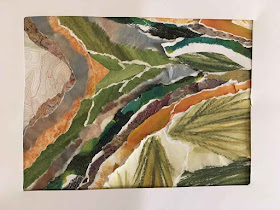It was fun to be introduced to so many new-to-me techniques, including weaving a window in the surface of the tapestry, adding novelty yarns, adding on surface embellishments such as wrapped and coiled pipe cleaners and bits of clothesline, and twining, crochet and beadwork techniques as part of the woven surface. Rowen told us our workshop weaving would not be a coherent work of art, and she was right, at least in my case. It's a funky little thing, but it will be a good reminder to me of some of the things we tried.
 |
| Molly Elkind, mixed media sample from Rowen Schussheim-Anderson workshop, 2018. That's my painted paper in the window. |
 |
| Molly Elkind, Pedernal study |
 |
| Molly Elkind, paper collage from Rowen Schussheim-Anderson workshop, 2018 |
 |
The most eye-opening thing for me about Rowen's workshop was simply being given permission to think outside the box, to let go of traditional notions of pure tapestry: warp faced, using mostly wool wefts, perfectly flat and straight-edged. My tapestry teachers up to now have been incredibly gifted practitioners of this traditional approach, and so I have worked within those parameters. But I love the idea that a tapestry can itself be a collage, with various disparate and surprising elements layered and juxtaposed. I've been saying to friends that Rowen's workshop "blew the lid off my traditional tapestry box."
Tune in next week to find out how my thinking did a 180 when I heard Irvin Trujillo's comments on working inside the box.



Oh, Molly, this is so exciting. I've been mulling over this sort of an approach for quite awhile now, and to have one of MY teachers sharing it is very inspiring. This is how I learned to weave way back in the 60s and on into the 70s, and I particularly think it is what the collage I did in your Convergence class is wanting. I think, by nature, I'm an "out of the box" sort of person, but in weaving, there is certainly a beauty and elegance to staying inside the box. Looking forward to your thoughts on "inside the box" next week.
ReplyDeleteLinda, I’ve admired your work for a long time, so your kind words mean a lot to me. I’m glad you found the post helpful. Looking forward to seeing the progress on your newest piece! Looks amazing so far!
DeleteThanks, Molly. I think we have a mutual admiration society going! :)
Deleteblowing the lid off is my cup of tea. Thank you so much, Molly, for posting this.
ReplyDeleteYou’re welcome! Thanks for reading!
DeleteWow, I love this concept and this piece! And using the maps is such an interesting basis for a start. Thank you, Molly!
ReplyDeleteThanks, Lynn!
Delete